新版PEP小学英语六年级下册Unit4教学设计
- 格式:doc
- 大小:69.00 KB
- 文档页数:18
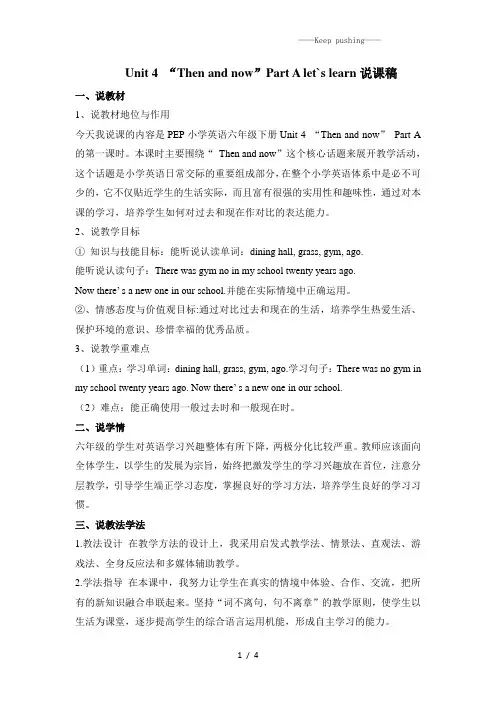
Unit 4 “Then and now”Part A let`s learn说课稿一、说教材1、说教材地位与作用今天我说课的内容是PEP小学英语六年级下册Unit 4 “Then and now”Part A 的第一课时。
本课时主要围绕“Then and now”这个核心话题来展开教学活动,这个话题是小学英语日常交际的重要组成部分,在整个小学英语体系中是必不可少的,它不仅贴近学生的生活实际,而且富有很强的实用性和趣味性,通过对本课的学习,培养学生如何对过去和现在作对比的表达能力。
2、说教学目标①知识与技能目标:能听说认读单词:dining hall, grass, gym, ago.能听说认读句子:There was gym no in my school twenty years ago.Now there’ s a new one in our school.并能在实际情境中正确运用。
②、情感态度与价值观目标:通过对比过去和现在的生活,培养学生热爱生活、保护环境的意识、珍惜幸福的优秀品质。
3、说教学重难点(1)重点:学习单词:dining hall, grass, gym, ago.学习句子:There was no gym in my school twenty years ago. Now there’ s a new one in our school.(2)难点:能正确使用一般过去时和一般现在时。
二、说学情六年级的学生对英语学习兴趣整体有所下降,两极分化比较严重。
教师应该面向全体学生,以学生的发展为宗旨,始终把激发学生的学习兴趣放在首位,注意分层教学,引导学生端正学习态度,掌握良好的学习方法,培养学生良好的学习习惯。
三、说教法学法1.教法设计在教学方法的设计上,我采用启发式教学法、情景法、直观法、游戏法、全身反应法和多媒体辅助教学。
2.学法指导在本课中,我努力让学生在真实的情境中体验、合作、交流,把所有的新知识融合串联起来。
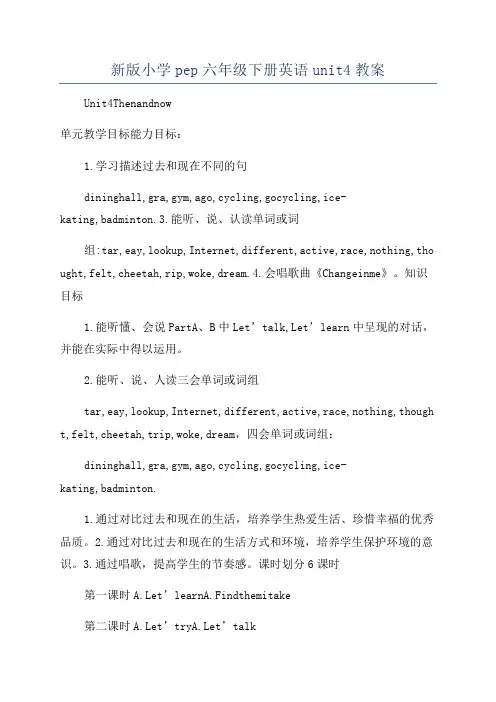
新版小学pep六年级下册英语unit4教案Unit4Thenandnow单元教学目标能力目标:1.学习描述过去和现在不同的句dininghall,gra,gym,ago,cycling,gocycling,ice-kating,badminton.3.能听、说、认读单词或词组:tar,eay,lookup,Internet,different,active,race,nothing,tho ught,felt,cheetah,rip,woke,dream.4.会唱歌曲《Changeinme》。
知识目标1.能听懂、会说PartA、B中Let’talk,Let’learn中呈现的对话,并能在实际中得以运用。
2.能听、说、人读三会单词或词组tar,eay,lookup,Internet,different,active,race,nothing,though t,felt,cheetah,trip,woke,dream,四会单词或词组:dininghall,gra,gym,ago,cycling,gocycling,ice-kating,badminton.1.通过对比过去和现在的生活,培养学生热爱生活、珍惜幸福的优秀品质。
2.通过对比过去和现在的生活方式和环境,培养学生保护环境的意识。
3.通过唱歌,提高学生的节奏感。
课时划分6课时第一课时A.Let’learnA.Findthemitake第二课时A.Let’tryA.Let’talk第三课时B.Let’learnB.L iten,match,anday第四课时B.Let’tryB.Let’talk第五课时B.Readandwrite第一课时ALet’learn&Findthemitake一、教学目标与要求:1.能够听、说、读、写以下七个单词和词组:dininghall,gra,gym,ago,year,month,lat。
2.能够正确运用上述七个单词和词组谈论或描述过去到现在发生的变化。
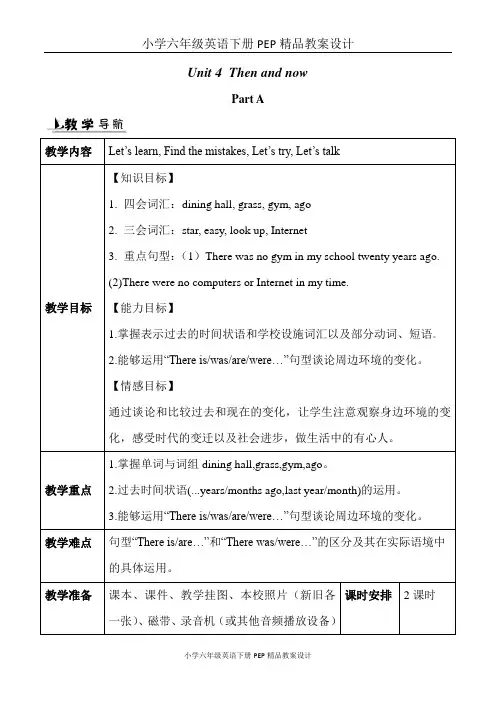
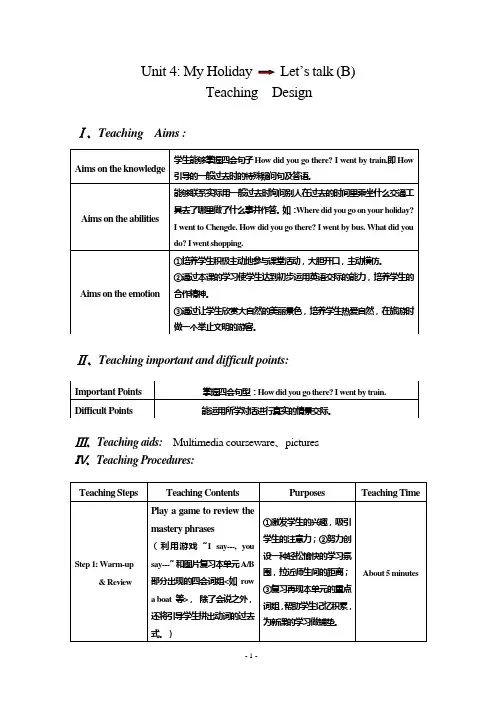
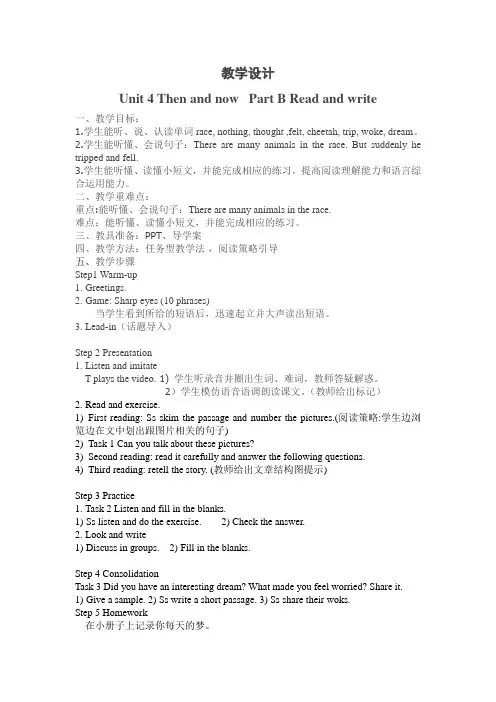
教学设计Unit 4 Then and now Part B Read and write一、教学目标:1.学生能听、说、认读单词race, nothing, thought ,felt, cheetah, trip, woke, dream。
2.学生能听懂、会说句子:There are many animals in the race. But suddenly he tripped and fell.3.学生能听懂、读懂小短文,并能完成相应的练习,提高阅读理解能力和语言综合运用能力。
二、教学重难点:重点:能听懂、会说句子:There are many animals in the race.难点:能听懂、读懂小短文,并能完成相应的练习。
三、教具准备:PPT、导学案四、教学方法:任务型教学法,阅读策略引导五、教学步骤Step1 Warm-up1.Greetings.2.Game: Sharp eyes (10 phrases)当学生看到所给的短语后,迅速起立并大声读出短语。
3.Lead-in(话题导入)Step 2 Presentation1.Listen and imitateT plays the video. 1) 学生听录音并圈出生词、难词,教师答疑解惑。
2)学生模仿语音语调朗读课文。
(教师给出标记)2.Read and exercise.1) First reading: Ss skim the passage and number the pictures.(阅读策略:学生边浏览边在文中划出跟图片相关的句子)2) Task 1 Can you talk about these pictures?3) Second reading: read it carefully and answer the following questions.4) Third reading: retell the story. (教师给出文章结构图提示)Step 3 Practice1.Task 2 Listen and fill in the blanks.1)Ss listen and do the exercise. 2) Check the answer.2.Look and write1)Discuss in groups. 2) Fill in the blanks.Step 4 ConsolidationTask 3 Did you have an interesting dream? What made you feel worried? Share it. 1)Give a sample. 2) Ss write a short passage. 3) Ss share their woks.Step 5 Homework在小册子上记录你每天的梦。
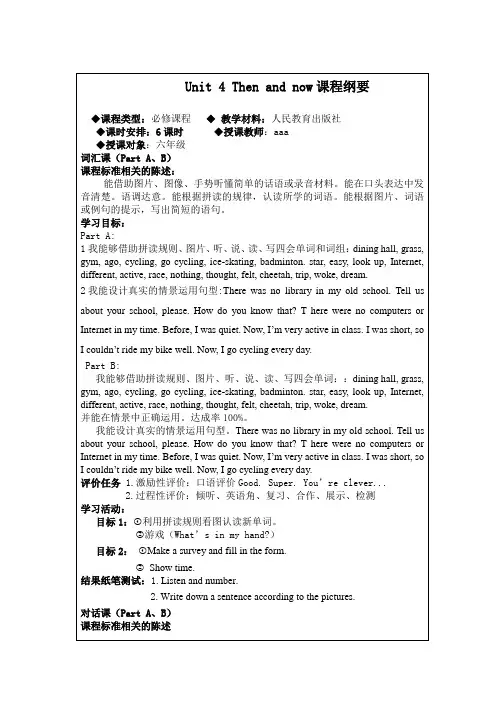
Unit 4 Then and now课程纲要◆课程类型:必修课程◆教学材料:人民教育出版社◆课时安排:6课时◆授课教师:aaa◆授课对象:六年级词汇课(Part A、B)课程标准相关的陈述:能借助图片、图像、手势听懂简单的话语或录音材料。
能在口头表达中发音清楚。
语调达意。
能根据拼读的规律,认读所学的词语。
能根据图片、词语或例句的提示,写出简短的语句。
学习目标:Part A:1我能够借助拼读规则、图片、听、说、读、写四会单词和词组:dining hall, grass, gym, ago, cycling, go cycling, ice-skating, badminton. star, easy, look up, Internet, different, active, race, nothing, thought, felt, cheetah, trip, woke, dream.2我能设计真实的情景运用句型:There was no library in my old school. Tell us about your school, please. How do you know that? T here were no computers or Internet in my time. Before, I was quiet. Now, I’m very active in class. I was short, so I couldn’t ride my bike well. Now, I go cycling every day.Part B:我能够借助拼读规则、图片、听、说、读、写四会单词::dining hall, grass, gym, ago, cycling, go cycling, ice-skating, badminton. star, easy, look up, Internet, different, active, race, nothing, thought, felt, cheetah, trip, woke, dream.并能在情景中正确运用。
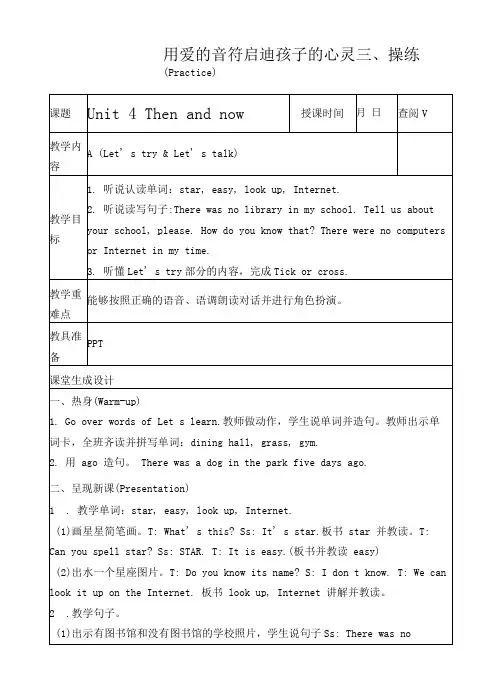
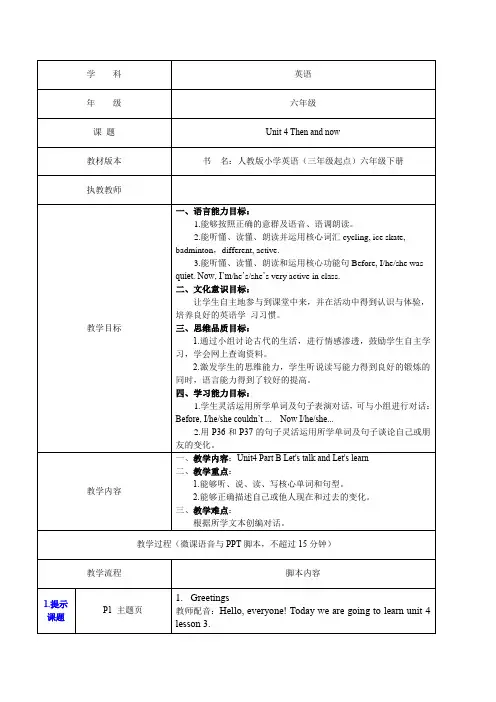
be句型的一般过去时表达。
1718Practice(片段7)Now,can you talk about more changes in Wu Binbin’s school? Work in pairs. I am first. There was no grass in my school twenty years ago. Your turn. Now, exchange, you are first. T: Now, there’s a new one in our school.You can practice with your family or by yourself. I think you can do it well.T: Boys and girls, we know the changes in Wu Binbin’s school well. Let’s help him finish his passage. Please read it again!【设计意图】:对话替换操练和补全文章的练习,强化核心句型There was的运用,综合运用所学知识。
1923Task: Find the mistakes(片段8)Now,there is another task for you—Find the mistakes.These sentences “There was/were … People didn’t … People couldn’t…” can help you., let’s watch.At that time, there was no gym. There was no post office.We also can use There were… There were no gyms. There were no post offices. Look at this picture, people didn’t go by bus. How about the other pictures? At last,people can’t use the Internet. Try to find more mistakes.【设计意图】:综合运用所学知识,强化核心句型There was的运用。
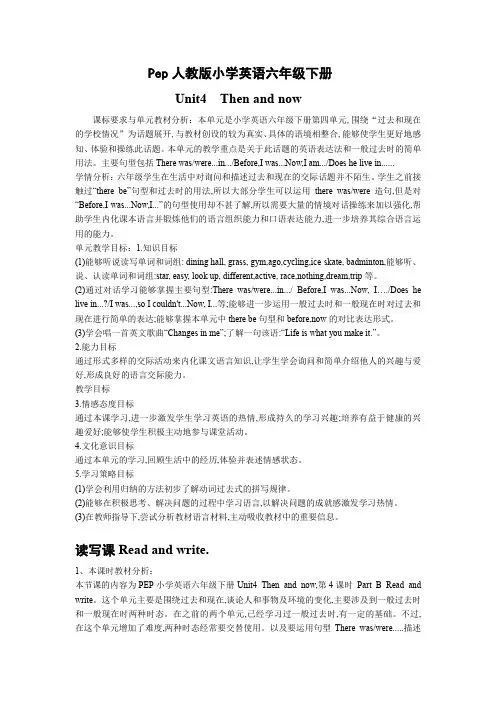
Pep人教版小学英语六年级下册Unit4 Then and now课标要求与单元教材分析:本单元是小学英语六年级下册第四单元,围绕“过去和现在的学校情况”为话题展开,与教材创设的较为真实、具体的语境相整合,能够使学生更好地感知、体验和操练此话题。
本单元的教学重点是关于此话题的英语表达法和一般过去时的简单用法。
主要句型包括There was/were...in.../Before,I was...Now,I am.../Does he live in......学情分析:六年级学生在生活中对询问和描述过去和现在的交际话题并不陌生。
学生之前接触过“there be”句型和过去时的用法,所以大部分学生可以运用there was/were造句,但是对“Before,I was...Now,I...”的句型使用却不甚了解,所以需要大量的情境对话操练来加以强化,帮助学生内化课本语言并锻炼他们的语言组织能力和口语表达能力,进一步培养其综合语言运用的能力。
单元教学目标:1.知识目标(1)能够听说读写单词和词组: dining hall, grass, gym,ago,cycling,ice-skate, badminton,能够听、说、认读单词和词组:star, easy, look up, different,active, race,nothing,dream,trip等。
(2)通过对话学习能够掌握主要句型:There was/were...in.../ Before,I was...Now, I…./Does he live in...?/I was...,so I couldn't...Now, I...等;能够进一步运用一般过去时和一般现在时对过去和现在进行简单的表达;能够掌握本单元中there be句型和before,now的对比表达形式。
(3)学会唱一首英文歌曲“Changes in me”;了解一句该语:“Life is what you make it.”。
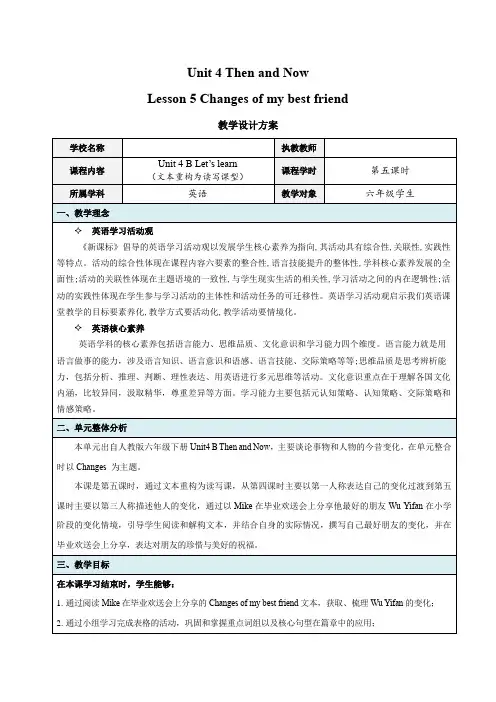
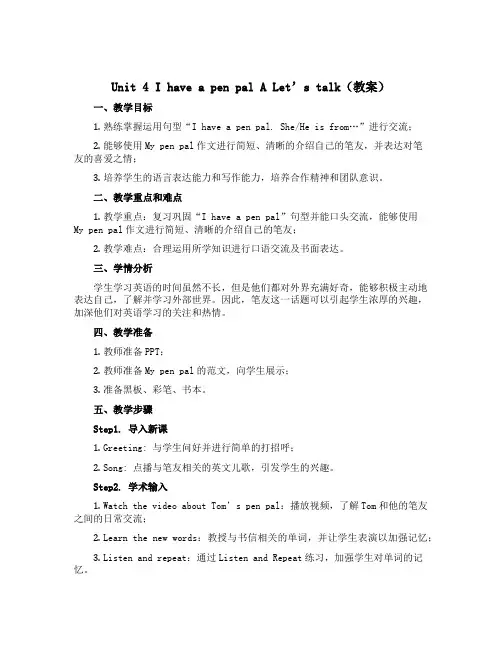
Unit 4 I have a pen pal A Let’s talk(教案)一、教学目标1.熟练掌握运用句型“I have a pen pal. She/He is from…”进行交流;2.能够使用My pen pal作文进行简短、清晰的介绍自己的笔友,并表达对笔友的喜爱之情;3.培养学生的语言表达能力和写作能力,培养合作精神和团队意识。
二、教学重点和难点1.教学重点:复习巩固“I have a pen pal”句型并能口头交流,能够使用My pen pal作文进行简短、清晰的介绍自己的笔友;2.教学难点:合理运用所学知识进行口语交流及书面表达。
三、学情分析学生学习英语的时间虽然不长,但是他们都对外界充满好奇,能够积极主动地表达自己,了解并学习外部世界。
因此,笔友这一话题可以引起学生浓厚的兴趣,加深他们对英语学习的关注和热情。
四、教学准备1.教师准备PPT;2.教师准备My pen pal的范文,向学生展示;3.准备黑板、彩笔、书本。
五、教学步骤Step1. 导入新课1.Greeting: 与学生问好并进行简单的打招呼;2.Song: 点播与笔友相关的英文儿歌,引发学生的兴趣。
Step2. 学术输入1.Watch the video about Tom’s pen pal:播放视频,了解Tom和他的笔友之间的日常交流;2.Learn the new words:教授与书信相关的单词,并让学生表演以加强记忆;3.Listen and repeat:通过Listen and Repeat练习,加强学生对单词的记忆。
Step3. 学科输出1.Follow the tape and chant together:带着学生一起朗读课文,并呈现课文的上下文信息;2.Pair work:学生以两人为一组,自由交换关于笔友的信息,运用所学语言表达情感;3.Group work:多人小组讨论并撰写My pen pal作文,并在班级中进行分享;4.Wrap-up: 教师对本堂课的内容进行复习和总结。
Unit 4 Then and nowPart B 第一课时 (1)Part B 第二课时 (4)Part B 第三课时 (7)Part B 第四课时 (9)Part B 第一课时Let’s try & Let’s talk教学目标1.能听、说、认读different,active等单词。
2.能听懂、会说本课时的对话。
3.运用句型“Before,I was … Now,I’m …”描述自己与他人的变化。
教学重点1.完成目标听力任务。
2.理解Let’s talk的对话内容。
教学难点1.different的发音及用法。
2.运用句型“Before,I was … Now,I’m …”描述自己与他人的变化。
教学准备1.单词卡片2.录音机及录音带或教学光盘3.多媒体课件4.学生准备自己小时候和现在的照片教学过程Step 1:Warm-up1.师生相互问候。
2.复习单词和重点句子。
(1)Bomb Game.规则:教师在课件中反复呈现本课词组的图片,其中穿插炸弹图片。
如果学生看到词组图片时,立即大声读出;如果学生看到炸弹图片时要用手捂住耳朵并迅速趴在桌子上“躲避”。
(进行游戏时,出示图片要由慢到快;教师可以先带小组读单词,开火车读单词。
等到学生对单词比较熟悉时,再让学生看图片,说单词。
)(2)Guess,Guess,Guess.规则:教师在课件上出示单词卡片(含配图与单词),遮住单词的一部分(开头或者结尾),学生快速猜测并读出该单词。
3.教师请学生拿出收集的所在城市的10年前和现在的照片及做成的海报,六人一组讨论,每人派一名代表在班里向大家展示和介绍。
Step 2:Presentation1.Let’s try.(1)教师在课件上出示自己的一张近照,请学生描述;教师请学生猜猜自己以前的模样,然后出示自己以前的照片作自我介绍。
(2)教师在课件上呈现一幅Mike和朋友在看老照片的图片,先让学生猜猜他们在看什么,引出对话背景。
PEP小学英语六年级下册Unit4 PartB Let's talk 教学设计【教学目标】1、能够在实际情境中运用本单元所学的日常用语。
2、能够听懂并理解本单元的日常对话。
3、能够熟练运用本单元所学的语言知识和语法规则,能够正确地使用一般现在时和动词“can”。
4、能够口头表达自己的想法和意见,并理解他人的观点。
【教学重点】1、能够运用本单元的日常用语。
2、能够听懂并理解本单元的日常对话。
3、能够正确地使用一般现在时和动词“can”。
【教学难点】1、能够口头表达自己的想法和意见,并理解他人的观点。
2、能够熟练运用本单元所学的语言知识和语法规则。
【教学准备】PPT课件、学生本【教学过程】Step 1:GreetingsGood morning/afternoon, boys and girls.How are you today?Step 2:Warm-up Activity1. T: Today we are going to talk about favorite TV shows. What is your favorite TV show, Amy?S1: My favorite TV show is Animal World.2. T: Great. And what about you, Mike?S2: My favorite TV show is Tom and Jerry.3. T: Thanks, Mike. Can you tell us why you like Tom and Jerry? S2: Because it's funny.4. T: So, today we are going to learn how to talk about our favorite TV shows. First, let's review the names of some TV shows.Step 3:Presentation1. T: Now let's look at some pictures of TV shows. Can you tell me what the TV show is?(Show the pictures of some TV shows to students)Ss: It's Sponge Bob.T: Good job. And what is Sponge Bob about?Ss: It's about a sponge who lives in the sea.T: Great. Let's look at another one.(Show the pictures of some TV shows to students)Ss: It's Doraemon.T: Good job. And what is Doraemon about?Ss: It's about a cat who helps a boy.2. T: Now let's practice talking about TV shows. Can you all say: "My favorite TV show is..."?Ss: My favorite TV show is…3. T: Great. Now, let's practice talking about TV shows that we like and don't like using "I like" and "I don't like".(Show the pictures of some TV shows to students)T: For example, I like Sponge Bob. But I don't like Peppa Pig. What about you?Ss: I like...Ss: I don't like...4. T: Now let's practice talking about TV shows that we are watching using present continuous tense.(Show the pictures of some TV shows to students)T: For example, I am watching Doraemon. What about you? Ss: I am watching...Step 4:Practice1. T: Now, let's practice using the language we just learned. Please use the following patterns to make a sentence:I like (TV show).I don't like (TV show).I am watching (TV show).Ss: I like Sponge Bob.Ss: I don't like Peppa Pig.Ss: I am watching Doraemon.2. T: Very good. Now let's practice using "can". Can you all say: "I can..."?Ss: I can...T: Great. Now let's look at some pictures of things we can do. (Show the pictures of some things that we can do to students)T: Can you all say what you can do?Ss: I can cook.3. T: Now let's practice using "can" to make a sentence. Please use the following patterns to make a sentence:Can you...?Yes, I can. / No, I can't.Ss: Can you cook?Ss: Yes, I can. / No, I can't.Step 5:Summary1. T: We have learned how to talk about our favorite TV shows and things we can do. Can you all say something you have learned today?Ss: I have learned how to talk about my favorite TV show.Ss: I have learned how to use "can".2. T: Good job. Now, let's review what we have learned today witha game.(Play a review game with students)Step 6:Homework1. T: Please practice using the language we learned today with your friends and family.2. T: Please write a short paragraph about your favorite TV show or something you can do using the language we learned today. 【教学反思】本节课主要针对六年级小学生的学习情况,以鲜明的主题、生动的图片及语言组织坐实为孩子们的学习提供了很好的支持,从而使孩子们能够在生活中真正的运用所学,然后确立语言能力和语言技能,并且在实际交际中逐渐提高。
六年级下册英语教学设计-Unit 4 Free Time-人教新起点 (4)一、教学目标1.能听懂、会说、会读、会写以下单词和词组:swimming, skating, cycling, watching TV, playing the guitar, fishing, playing chess, playing cards, playing video games, playing computer games2.能听懂、会说、会读、会写以下句子:•What’s your hobby?•My hobby is swimming/cycling/skating/watching TV/playing theguitar/fishing.3.能掌握如何询问他人兴趣爱好,并能介绍自己的兴趣爱好。
二、教学内容1.英语单词:swimming, skating, cycling, watching TV, playing the guitar, fishing, playing chess, playing cards, playing video games, playing computer games2.英语句子:•What’s your hobby?•My hobby is swimming/cycling/skating/watching TV/playing theguitar/fishing.三、教学重难点1.英语单词和句子的掌握。
四、教学准备1.投影仪和计算机2.英语教材和课件3.英语单词和句子的练习卡片五、教学过程1. Warm-up教师通过展示一些图片或直接提问,与学生进行问答练习。
e.g.T: What’s your hobby?S1: My hobby is reading.T: What’s your favorite food?S2: My favorite food is pizza.2. Presentation教师以图片和示范的方式向学生展示新单词,并帮助学生逐步理解含义。
人教PEP版六年级英语下册Unit4单元教案作为一名人民教师,常常要根据教学需要编写教案,编写教案有利于我们科学、合理地支配课堂时间。
来参考自己需要的教案吧!以下是店铺收集整理的人教PEP版六年级英语下册Unit 4单元教案,希望对大家有所帮助。
人教PEP版六年级英语下册Unit 4单元教案篇1第一课时教学目标1.能够听懂、读懂句子:There was only one small building on a hill. I looked it up on the Internet.2.能够完成Lets try部分的练习。
3.能够听懂、读懂对话,并进行角色表演。
4.能够根据学校实际,运用there be 结构描述学校过去和现在的变化,正确使用there was/were和there is/are,会用could+动词原形表示过去。
教学重点1.能用there was/were句型描述过去的情况。
2.正确使用时间状语,区分使用一般过去时和一般将来时。
教学难点1.能够根据学校实际,运用there be 结构描述学校过去和现在的变化。
2.会用could表示一般过去时。
教学准备教师准备:1.本课时的录音。
2.本课时的教学挂图。
3.一张学校的老照片。
4.本课时的教学课件。
学生准备:1.水彩笔。
2.白纸。
教学方法1.角色表演教学法利用Lets talk 中的对话,学生分角色朗读对话。
在训练学生口语的同时,让学生熟练掌握there be 句型的一般过去时(表示过去存在)的用法。
2.情境教学法教师把以前的旧照片展示给同学,创设情景,让同学根据照片的内容用there was/there were 去描述,理解there was/there were 指过去某地有某物。
教学过程Step 1: Warm-up1.教师热情地和学生打招呼问好,做简单的Free talk。
如:T: How was your weekend?S1: It was great.T: Where did you go last weekend?S1: I went to the zoo.T: What did you do there?S1: I saw many monkeys and took lots of pictures.2.教师播放四年级下册第一单元Lets sing—Our school,师生一起唱,创设气氛。